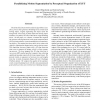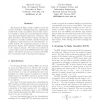ICPR
2004
IEEE
16 years 2 months ago
2004
IEEE
Robotic navigation algorithms increasingly make use of the panoramic field of view provided by omnidirectional images to assist with localization tasks. Since the images taken by ...
105
Voted
ICPR
2004
IEEE
16 years 2 months ago
2004
IEEE
The front end of many motion analysis algorithms is usually a process that generates bounding boxes around each moving object, roughly segmenting the objects from the background. ...
88
Voted
ICPR
2004
IEEE
16 years 2 months ago
2004
IEEE
The paper presents a robust digital image watermarking scheme that uses both the characteristics of the human visual system (HVS) and statistical information measure. Spread trans...
104
click to vote
ICPR
2004
IEEE
16 years 2 months ago
2004
IEEE
The Scanning N-Tuple classifier (SNT) is a fast and accurate method for classifying sequences. Applications include both on-line and off-line hand-written character recognition. S...
ICPR
2004
IEEE
16 years 2 months ago
2004
IEEE
In augmented virtuality, estimating object surface reflectance properties is important when rendering objects under arbitrary illuminationconditions. However, faithfully estimatin...
106
click to vote
ICPR
2004
IEEE
16 years 2 months ago
2004
IEEE
In an experiment with a soccer playing robot, periodic temporally-constrained nonlinear principal component neural networks (NLPCNNs) are shown to characterize humanoid motion eff...
107
click to vote
ICPR
2004
IEEE
16 years 2 months ago
2004
IEEE
The performance of face recognition systems that use twodimensional (2D) images is dependent on consistent conditions such as lighting, pose and facial expression. We are developi...
ICPR
2004
IEEE
16 years 2 months ago
2004
IEEE
The efficiency of three tracking reliability metrics based on information theory and normalized correlation is examined in this paper. The two information theory tools used for th...
125
click to vote
ICPR
2004
IEEE
16 years 2 months ago
2004
IEEE
Corner matching constitutes a fundamental vision problem that serves as a building block of several important applications. The common approach to dealing with this problem starts...
ICPR
2004
IEEE
16 years 2 months ago
2004
IEEE
The visual appearance of an image is closely associated with its low-level features. Identifying the set of features that best characterizes the image is useful for tasks such as ...


